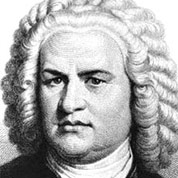BWV1013 Sarabande in A Minor by Johann Sebastian Bach (1685-1750)
 Johann Sebastian Bach was a German composer, organist, harpsichordist, violist, and violinist whose sacred and secular works for choir, orchestra, and solo instruments drew together the strands of the Baroque period and brought it to its ultimate maturity. |



Notes
Chamber Music. Partita for unaccompanied flute. The sarabande is a slow and stately dance in triple meter with an accent on the second beat. It evolved from zarabanda, a dance from 16th century Mexico. Hold all bass notes as long as possible. keep the trills fast. The flute version is slightly different towards the end 1:33 onwards (listen to the midi) Notes here are actually many octaves higher-and sounds cooler. I have tried to play this at this range (beyond the 12 fret) but decided against it due to great difficulty. I am guessing that the flute’s tonal range can go much higher than a guitar. I feel the flute and guitar don’t translate as well as other instruments. Because of this I imagine, the guitar version of bwv1012 sarabande may be much harder to play than on the flute. Anyway, this is my 20th bach song. Enjoy!
Guitar Pro Playthrough
3/4 Time Signature. 46 Bars. Standard Tuning.
Pay extra attention to left fingering. Think about shortest distances between each chord. ie economy of movement. In order to make this song work. keep the bass note suspended. This is crucial as bach’s signature is counterpoints. 2 or more voices. If any left hand fingering seems awkward, please adapted to your own way.
Bar[6]-[8] and Bar[34]-[36]
Trills. that’s rapid pull off and hammer ons.
Bar[10]-[11] and Bar[40]-[43]
Semi Quavers – fastest part of the song. its not about speed but keeping the bass notes held and uniformity of tempo.
Bar[43] Hard Chord with pull off. Make sure your 4 fingers (left hand) are in chord position at the very beginning (before pull off). That means 1st on D, 2nd on G#, 3rd on E and 4th on E#.
